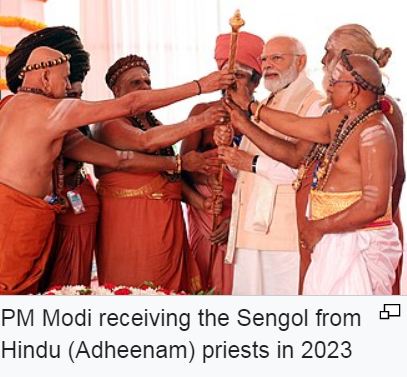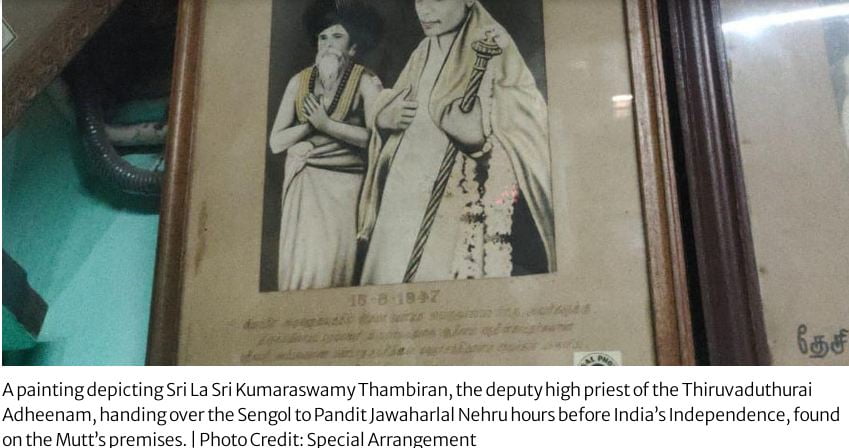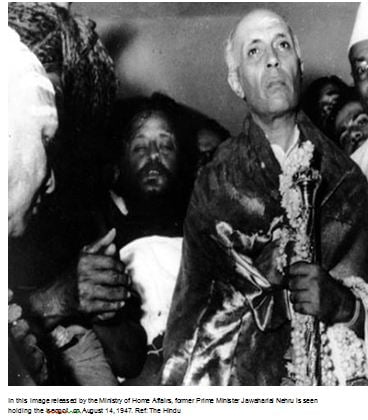
“Sengol: From Ancient Symbol to Modern Inspiration” explores the fascinating journey of the Sengol, a symbol of authority and righteous rule in Tamil culture. Discover its ancient origins, its role in India’s independence, and its continued significance as a modern inspiration for leadership and governance. Learn about the Sengol’s rich history and cultural heritage in this comprehensive blog post.
The Sengol, a golden scepter steeped in history, isn’t just a relic – it’s a powerful symbol of just and righteous rule. Embark on a journey through time to explore its ancient origins, controversial present, and the inspiring message it holds for modern leaders and citizens alike. Discover how this timeless symbol can guide us toward a future where justice and fairness prevail.
Unveiling the Sengol: Symbol of Righteous Rule
When we want to know about sengol lot of keywords/words/ questions come in our minds as what is the meaning of sengol, Sengol significance, what is singol, singol kya h, singol kya hai, what is sengol, singol rajdand, history of singol, sengol का इतिहास , singol of india, singol india, sengol tamil nadu, who made sengol, sengol belongs to which dynasty, Who created Sengol? Is Sengol made of gold?, sengol Nehru, what is written on sengol, singol image, singol in parliament, sengol parliament, what is sengol in parliament in hindi, sengol controversy, what is sengol controversy and many more, in this blog we will go through all the answers to the questions in our mind.
1.What Is The Meaning Of Sengol
“Sengol,” meaning “righteous sceptre” in Tamil, carries immense historical and cultural significance. This handcrafted, gold-plated sceptre, adorned with a majestic Nandi bull, embodies ideals of just and fair governance.
While often translated as “scepter” Sangol in English transcends a mere object. It represents the transfer of power and a king’s responsibility to uphold righteousness (“semmai” in Tamil). Sengol meaning in hindi, its essence translates to “nyayasheel rajdan,” or just rule.
2.Sengol’s Significance: Legacy of Righteous Rule
The Sengol is a handcrafted, gold-plated scepter about five feet (1.5 m) long, and has a diameter of about three inches (76 mm) at the top and one inch (25 mm) at the bottom.
The Sangol, a gold-plated scepter crowned with a Nandi bull, isn’t just a relic of India’s past; it’s a powerful symbol resonating even today, more Rooted in the Tamil word “semmai,” meaning righteousness, its significance unfolds across historical, cultural, and contemporary spheres.
Historically, the Sangol adorned Chola kings, reminding them of their duty to govern with justice and fairness.expand_more It wasn’t just a scepter; it was a responsibility embodied. This association with just rule finds resonance in Hindi as “nyayasheel rajdan.”
Culturally, the Sangol is woven into Tamil literature. “Silapathikaram” depicts a prosperous land under a righteous Sengol-wielding king, highlighting the link between just leadership and societal well-being.
3. Who created Sengol?
The Sangol was crafted by Vummidi Ethiraju of the Vummidi Bangaru Chetty family. Vummidi Bangaru Chetty, a jeweller from Chennai. The Sangol is a handcrafted, gold-plated scepter about five feet (1.5 m) long, and has a diameter of about three inches (76 mm) at the top and one inch (25 mm) at the bottom. It is made of over 100 sovereigns of gold and silver is engraved with intricate designs and details.
The Sengol represents the rich Tamil culture and is said to have been used by the Chola kings. It symbolizes the king’s dharma or duty to rule his kingdom well. It reminds the king that he is responsible for the welfare of his subjects and that he must rule with justice and fairness.
4. Is Sengol made of Gold?

The Sangol is made of gold and silver, which are considered to be precious metals in Hindu tradition. The design of the Sangol is based on the traditional Tamil sceptre, which is a symbol of power and authority. The Sengol is made of gold and silver, which are considered to be precious metals in Hindu tradition.
Nandi: The top of the Sengol is adorned with a statue of a Nandi, which is a sacred animal in Hinduism. The Nandi represents dharma, which is the Hindu concept of Justice.
Goddess Lakshmi: The second layer is engraved with the image of the goddess Lakshmi, the Hindu goddess of wealth and prosperity. Her presence is meant to bring financial success and good luck.
Kodimaram: The stem is engraved with the image of Kodimaram, a sacred tree that is associated with the Hindu god Vishnu. Kodimaram is a symbol of growth and fertility. Together, the three layers of the Sengol represent the three pillars of a successful life: justice, wealth, and growth.
5. History of Sengol: A Righteous Scepter
In the heart of India’s cultural tapestry, lies a unique symbol – the Sangol. This gold-plated scepter, adorned with a majestic Nandi bull, transcends its tangible form and whispers tales of ancient traditions, ideals of righteous rule, and a fascinating journey through time. Let’s delve into the rich history of the Sangol, exploring its origins, significance, and its contemporary embodiment.
6. Sengol From Chola Legacy to National Symbol:
The roots lie in the Chola Dynasty, a powerful South Indian empire renowned for its cultural and maritime prowess (3rd century BCE – 13th century CE). It symbolized the transfer of power from king to heir, reminding the new ruler of their responsibility to uphold justice and righteous governance (“semmai” in Tamil). The term “Sengol” itself translates to “scepter” in English, but carries the deeper meaning of “righteous staff”.

i)The Gift of Independence:
Fast forward to 1947, on the eve of India’s independence. Seeking a unique and symbolically potent ceremony for the transfer of power from the British, the first Prime Minister, Jawaharlal Nehru, sought advice. Thiruvavaduthurai Adheenam, a revered spiritual institution from Tamil Nadu (sangol tamil nadu), gifted Nehru a specially crafted Sangol, imbued with ancient tradition and signifying the dawn of a new era.
ii)Beyond History: Enduring Significance:
The Sangol’s significance extends far beyond its historical context. It serves as a potent reminder of the ideals of just and righteous rule, a call to leaders to prioritize the well-being of their people. The inscription on the Sengol reads “Yaadhumai Indraa Yedhumai Ezhuthu”, meaning “All people are my kin, all lands are my fields,” encapsulating the spirit of inclusivity and equality.
7.Modi, Sengol, & Modern India: A Controversial Narrative
The 2023 installation of the Sangol in India’s new Parliament, under Prime Minister Modi’s leadership, brought the historical sceptre into the spotlight. However, the narrative presented by the government sparked controversy.
While the Sangol traditionally symbolized righteous rule, the government associated it with the transfer of power from Britain, a claim disputed by historians. This narrative aimed to connect the Chola dynasty, known for its maritime prowess, with modern India’s aspirations, aligning with Modi’s “Amrit Kaal” vision.
Critics argue that this appropriation of a Tamil symbol ignores its complex history and overlooks potential regional or religious biases. They point out that the Sengol historically represented fairness and equity, not necessarily nationalistic expansion.
The Sangol’s presence in the Parliament serves as a reminder of historical continuity, but interpretations of its meaning remain contested. Its modern relevance lies in its ability to spark discussions about just governance, historical narratives, and regional representation within a diverse nation like India.
More Than Just a Relic:
The Sangol’s journey transcends mere history. It’s a living symbol, inspiring conversations about responsible leadership, ethical governance, and the pursuit of a just society. Its presence in the modern political landscape serves as a powerful affirmation of India’s commitment to these ideals.
8. Beyond Dynasty: A Shared Legacy – The Sengol’s Universality
While the Sangol finds its physical origin within the Chola dynasty, its significance expands far beyond the confines of a single lineage. The core idea at its heart – justice and righteous rule – resonates with diverse cultures and traditions across India, making it a shared legacy rather than just a dynastic one. Here’s why:
i)Universality of Justice:
The concept of justice is not exclusive to any specific dynasty or culture. It’s a fundamental human aspiration, present in diverse philosophies and religions across the globe. The Sengol, by embodying this ideal, connects with people regardless of their historical and cultural backgrounds.
ii)Transcending Regional Boundaries:
The Chola dynasty was not the only Indian kingdom to value just governance. Concepts like “Dharma” in Hinduism and “Dhamma” in Buddhism emphasize fair rule and righteous conduct for leaders. The Sengol, drawing on these universal themes, finds resonance in various regions across India.
iii)Symbolism Beyond Royalty:
The Sengol wasn’t solely bestowed upon kings. It also held significance in local traditions, representing justice and fairness at the community level. In Tamil Nadu, for instance, the Sengol symbol appears in village festivals and rituals, highlighting its connection to everyday life and common people.
iv)Modern Interpretations:
The placement of the said simbol in the Indian Parliament House further emphasizes its shared legacy. It represents not just a historical artifact, but an ongoing aspiration for just governance in the country’s democratic framework. This move transcends dynasties and signifies a commitment to a universal ideal.
9.The Power of Stories and Inspiration:
The Sengol’s story itself serves as an inspiration. It tells us that the pursuit of justice is not bound by time or place. It’s a continuous journey, and the Sengol becomes a symbol of that ongoing struggle, reminding us to strive for better and fairer societies.
The Sangol’s journey transcends dynastic boundaries. It carries a universal message of justice, fairness, and responsible leadership, resonating with people across cultures, regions, and generations. It stands as a reminder that the pursuit of a just society is a shared legacy, reminding us to continuously strive towards this ideal.
Future Reflections:
As India marches forward, the Sangol stands as a beacon, reminding us of the timeless relevance of righteous leadership. Its story inspires us to uphold its ideals, ensuring that the principles of justice and fairness continue to guide the nation’s future.
10. Flashback:
Relinquishment of British Control: At a critical juncture in history, Pandit Jawaharlal Nehru was approached by Lord Mountbatten for advice with the symbolic 1947 transfer of power to India. Shri C. Rajagopalachari, who researched the history and civilization of the region and discovered a solution by taking inspiration from the Chola monarchs, was advised by Pandit Jawaharlal Nehru.
Blessings of the Adheenams: The Adheenams are a non-brahmin Saivite order with a 500-year tradition. In 1947, they were summoned to Delhi by Shri Rajagolachari to approve and supervise the handover of power to Indians.
Meaning of the verse: Referencing blessings, Kolaru Padhigam by Tamil poet St. Thirugnanasambandar was recited during the 1947 handover of power. It’s thought that the verse has meaning for getting over challenges.
Ancient Dynasty and Important Symbol: The Sengol, a powerful symbol that subsequently came to be connected with India’s independence in August 1947, represented the handing over of sovereignty from one Chola monarch to the next. Throughout the Indian subcontinent, the Chola dynasty was well-known and ruled for a considerable amount of time. They ruled over various areas until the thirteenth century.

A Sign of Justice and Transfer of Power: The Sengol was commanded by the Adheenam as a representation of just governance. He was adorned with a splendid Nandi and was expertly created by the reputable jeweler Vummidi Bangaru Chetty.
In 1947, it was given to the soon-to-be Prime Minister Pandit Jawaharlal Nehru as a symbol of the transition of power before his momentous “Tryst with Destiny” speech, which he delivered in front of the Constituent Assembly to herald the birth of the country’s independent of British authority.
International Attention to the Historic Power Transfer: News reports on the historic power transfer drew considerable attention from around the world, highlighting the moment’s importance.
A Profound Memoir of The Sangol: On August 15, 1978, The Sangol, who had been hidden for a time, came to light once again thanks to the deep memories of the esteemed Maha Periava. The country expressed appreciation for his treasured memory of that momentous occasion.

The Everlasting Power: Symbols are very important since they have rich meanings and endure a long time. It signifies the transfer of authority to Indian hands, they provide the impression of something unique and precious to treasure.
You may also like: NIFT Revolution: 5 Life-Changing Secrets Only National Institute of Fashion & Technology (NIFT) Insiders Know, 2. Unveiling the Power of Blockchain Technology: Changing Future 3. 2024 Navigating the NFT Landscape : Unveiling the complexity of Non-Fungible Tokens, 4. METAVERSE Realities Redefining the Virtual Revolution 5. Internet of Things (IoT)-10 Mind-Blowing Secrets
11.What is Sengol Controversy?
“The Sengol controversy” erupted in 2023 surrounding the installation of the historic “Sengol” (golden scepter) in India’s new Parliament House. It ignited several points of contention:
i)Historical Claim:
-
- The government narrative portrayed the Sangol as used during the transfer of power from the British, symbolizing their relinquishment of control.
-
- Historians disputed this claim, arguing no documented evidence supports the British actively using the Sangol in the ceremony.
ii)Political Interpretation:
-
- Prime Minister Modi linked the Sangol to the Chola dynasty, known for its maritime power, aligning it with his vision of “Amrit Kaal” (golden age) for India.
-
- Critics accused the government of appropriating a Tamil symbol for nationalistic purposes, ignoring its complex history and potentially overlooking regional or religious implications.
iii)Symbolic Meaning:
-
- Traditionally, the Sangol embodied righteous rule and fair governance, not necessarily expansionism.
-
- By associating it with the British handover, some argued the government misrepresented its core ideals.
iv)Wider Concerns:
-
- Sangol Controversy highlighted concerns about historical narratives, interpretations, and how they are used for political agendas.
-
- It also brought up issues of regional representation and ensuring diverse voices are heard within the national narrative.
While the Sangol now resides in the Parliament, the controversy surrounding its meaning and interpretation continues. It serves as a complex reminder of the need for critical engagement with historical symbols, their uses, and potential biases.
12.What is Sengol in Parliament ?

The Sangol Parliament has recently gained attention in political discourse. The Sengol was put in the new Parliament building, Naya Sansad Bhavan, by the Indian government on May 28, 2023. Installing the Sengol next to the Speaker’s chair in the Lok Sabha chamber, Prime Minister Narendra Modi performed a pooja.
Modern India hasn’t forgotten the Sangol. In 2023, it found a new home in the Parliament House, serving as a visual reminder of the values upon which the nation is built. This placement signifies the ongoing pursuit of justice and good governance.
Thus, the Sangol’s significance extends far beyond its physical form. It’s a potent symbol of a long-held ideal, reminding leaders and citizens alike of the responsibility to strive for a just and righteous society.
The Sengol, a historically significant gold-plated scepter, currently resides in the Indian Parliament House but with some controversy surrounding its placement and meaning.
Here’s the breakdown:
1.What it is ?
-
- A 5-foot, handcrafted scepter adorned with a Nandi bull, traditionally symbolizing just and fair governance.
-
- Historically associated with the Chola dynasty, gifted to India’s first Prime Minister, Jawaharlal Nehru, on the eve of independence.
ii)Why it’s in Parliament ?
-
- Installed in 2023, its presence serves as a reminder of the ideals of righteous rule and justice in governance.
-
- Seen by some as a symbol of continuity, connecting India’s past to its present aspirations.
iii)The Controversy:
-
- The government narrative associating it with the British transfer of power is disputed by historians, lacking documented evidence.
-
- Concerns about appropriate usage of historical symbols and potential regional biases in the official interpretation.
iv)Significance Today:
-
- The Sangol sparks discussions about just leadership, historical narratives, and regional representation in a diverse nation.
-
- Its presence reminds us to critically engage with historical symbols and their interpretations.
13. Sengol: Beyond Symbolism, Towards Action
The Sangol, more than just a relic, invites us to engage in a continuous dialogue about the aspirations of just and righteous rule. While its physical form rests in the Parliament House, its true legacy unfolds in the actions it inspires.
i)From Ancient Ideals to Modern Responsibilities:
It reminds us that the pursuit of justice and fairness transcends specific dynasties or eras. It’s a universal human yearning, echoing in diverse philosophies and cultures across the globe. In the modern context, it calls upon leaders and citizens alike to uphold these ideals not just symbolically, but through concrete actions.
ii)Bridging the Gap Between Symbol and Practice:
The presence of the Sangol in the Parliament serves as a constant reminder of this responsibility. It challenges us to translate its symbolism into tangible efforts towards:
-
- Upholding the rule of law and ensuring equitable access to justice.
-
- Promoting ethical governance and combating corruption.
-
- Empowering communities and ensuring inclusive participation in decision-making.
-
- Fostering dialogue and reconciliation to address historical imbalances.
iii)A Legacy Unfolding:
The Sengol’s true significance lies not only in its past or its symbolic presence, but in its ability to inspire action in the present and shape a more just future. As we engage with its history and delve into its contemporary interpretations, let us remember that the legacy of the Sangol unfolds not merely through its unveiling, but through the ongoing pursuit of the ideals it embodies.
CONCLUSION:
The Sengol’s Call: More Than Words, More Than Gold
The Sengol, gleaming in the Parliament House, isn’t just a historical artifact; it’s a whisper from the past urging us to act in the present. We’ve unveiled its history, debated its meaning, but the true test lies in what we do next.
This golden scepter isn’t a magic wand for instant justice. It’s a reminder etched in metal: fair rule, ethical governance, and inclusivity aren’t abstract ideals, they’re everyday struggles.
So, let’s not just admire the Sangol from afar. Let’s challenge ourselves:
-
- Demand accountability from leaders, questioning decisions and seeking transparency.
-
- Raise our voices for marginalized communities, ensuring all have a seat at the table.
-
- Hold ourselves accountable too, practicing fairness and empathy in our daily interactions.
Remember, its legacy isn’t written in gold, but in our actions. Let’s make its message resonate, not just in the halls of power, but in the streets, schools, and homes across our nation. Let’s be the generation that heeds the Sengol’s call, building a future where its symbolism becomes reality.
Frequently Asked Questions:
What is a Sangol?
A Sangol is a traditional ceremonial scepter that has deep cultural and historical significance in Indian history, particularly in Tamil culture. It symbolizes authority, leadership, and the transfer of power.
What does the word ‘Sengol’ mean?
The term ‘Sengol’ is derived from the Tamil word ‘semmai,’ which means righteousness. Thus, the Sengol represents just and righteous rule.
What is the historical significance of the Sangol?
The Sangol has been a symbol of governance and righteous rule since ancient times in Tamil Nadu. It was used during coronation ceremonies to signify the transfer of power from one ruler to another.
How was the Sangol used in India’s independence?
During India’s independence in 1947, a Sengol was presented to Prime Minister Jawaharlal Nehru by Lord Mountbatten, the last British Viceroy of India. This act symbolized the transfer of power from British rule to independent India.
Where is the Sangol kept today?
The Sengol used during India’s independence is preserved in the Nehru Gallery of the Allahabad Museum in Uttar Pradesh, India.
What is the significance of the Sengol in modern times?
In modern times, the Sengol serves as a reminder of India’s rich cultural heritage and the importance of righteous governance. It is a symbol of India’s struggle for freedom and the transfer of power to a sovereign nation.
Are there any ceremonies involving the Sangol today?
While there are no specific ceremonies involving the Sangol today, it is revered and respected as a historical artifact. It occasionally features in cultural exhibitions and events that celebrate India’s independence and heritage.
Can the public view the Sangol?
Yes, the Sangol can be viewed by the public at the Allahabad Museum, where it is displayed as part of India’s historical legacy.
Is the Sangol unique to Tamil culture?
While the Sangol has its roots in Tamil culture, the concept of a ceremonial scepter symbolizing authority and governance is present in various cultures around the world. However, the Sengol’s specific design and historical context are unique to Tamil Nadu.

